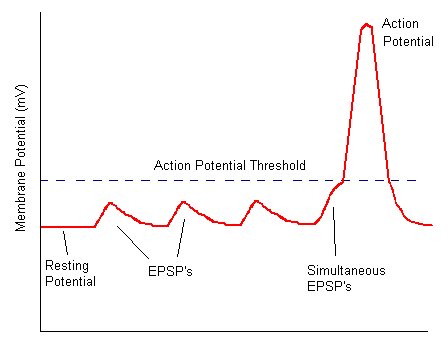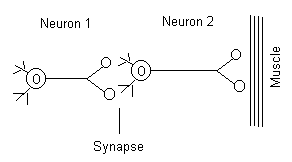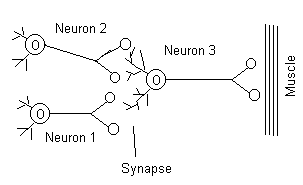
SYNAPSE TRANSMISSION
Introduction: The nervous system depends on neurons working together to transmit signals. Neurons are special cells that have plasma membranes capable of generating and conducting electric impulses. Each neuron is composed of dendrites that collect information from other neurons, a cell body where nerve impulses are initiated, an axon along which impulses are conducted, and axon terminals that synapse with a target cell such as another neuron or muscle tissue.
The electric potential of neurons is responsible for signal transmission. The inside of a neuron generally has an excess of negative charges. When a neuron is unstimulated, the difference in electric charge across the plasma membrane is the resting potential. A neuron is sensitive to physical or chemical changes that cause changes in the resting potential. A sudden and rapid reversal in charge across the membrane is called an action potential. When a neuron is stimulated, the action potential moves along the axon to the axon terminals to the target cell. The post-synaptic membrane of the target cell integrates the information it receives. In order for the target cell to be stimulated, the stimulus must be greater than the target cell's action potential. Neurotransmitters that affect the membrane bring about an excitatory postsynaptic potential (EPSP). When several EPSP's arrive at the cell body simultaneously, the potential is summed over the number of synaptic knobs, and an action potential may be reached.

Importance: Understanding resting and action potential can help us understand when a target cell will be stimulated. We can use simple mathematics to determine how strong a stimulus must be in order for a chain of neurons to cause a muscle to contract.
Question: How do membrane potential, action potential thresholds, and properties of neurons affect how nerve impulses stimulate muscles?
Variables:
|
Si |
stimulus power of neuron I (millivolts) |
|
Ski |
stimulus per knob (mv/knob) for neuron i |
|
Ki |
number of synaptic knobs on neuron i |
|
Ri |
resting potential of neuron i (mv) |
|
Ai |
action potential of neuron I (mv) |
Methods: We can use a simple algorithm to understand neuron transmission. Assume neuron 1 synapses with neuron 2. Neuron 2 synapses with a muscle cell. Assume neuron 1 is stimulated. We must determine if the impulse will pass over the synapse and stimulate neuron 2 and contract the muscle.
Model:

Data:
|
Neuron |
Stimulus per knob |
Resting Potential |
Action Potential |
|
1 |
+10 mv |
-60 mv |
-65 mv |
|
2 |
+5 mv |
-70 mv |
-45 mv |
Strategy:
1. First we determine the stimulus power of the first neuron. The stimulus power of neuron 1 (S) can be described as
S1 = Sk1 x k1
where Sk is the stimulus power per knob and k is the number of knobs. This stimulus will then pass to the target neuron as an EPSP. Here S1 = (+10 mv/knob) x (2 knobs)=20mv.
2. The stimulus from neuron 1 passes through the synapse to neuron 2. The membrane potential of the second neuron can then be calculated as
S2 = S1 + R2
where R2 is the resting potential of the second neuron. In this example, S2 = 20 mv + (-70mv) = -50 mv.
3. In order for neuron 2 to be stimulated and contract the muscle, the membrane potential must surpass the action potential threshold. In other words, S2 must be greater than the action potential of the 2nd neuron (S2 > A2). In the example, we check to see if -50mv is greater than
-45 mv. In fact, by the properties of negative numbers, -50 < -45, so the action potential does not occur and the muscle is not stimulated.
This algorithm can be extended to chains of more than 2 neurons. In this case, the stimulus power for each neuron is calculated and summed to determine the EPSP.
Conclusions: Notice that the stimulus power of the first neuron depends on the number of synaptic knobs the neuron possesses. As the number of knobs on a neuron increases, its potential to stimulate a target neuron increases. This is the idea of simultaneous EPSP's: one or two EPSP's may not be sufficient to stimulate the target neuron. However, if EPSP's arrive simultaneously, either through the presence of additional synaptic knobs or other neurons, the action potential may be reached.
Additional Questions:
1. In our example, assume that neuron 1 has 3 instead of 2 synaptic knobs. In this case, will the muscle contract?
2. Try the following example:

Use the following data:
|
Neuron |
Stimulus per knob |
Resting potential |
Action potential |
|
1 |
+10 mv |
-60 mv |
-70 mv |
|
2 |
+5 mv |
-70 mv |
-65 mv |
|
3 |
+10 mv |
-65 mv |
-60 mv |
Neurons 1 and 2 are stimulated simultaneously. Will neuron 3 fire off and cause the muscle to contract?
Sources: Stencel, J. E. 1992. Using algorithms in solving synapse transmission problems: Teaching difficult concepts through a problem-solving approach. Journal of College Science Teaching Sept/Oct:55-57.
Purves, W. K., G. H. Orians, H. C. Heller, and D. Sadava. 1998. Life: The Science of Biology (Fifth Edition). Sinauer Associates, Sunderland, MA.
Copyright 1999 M. Beals, L. Gross, S. Harrell